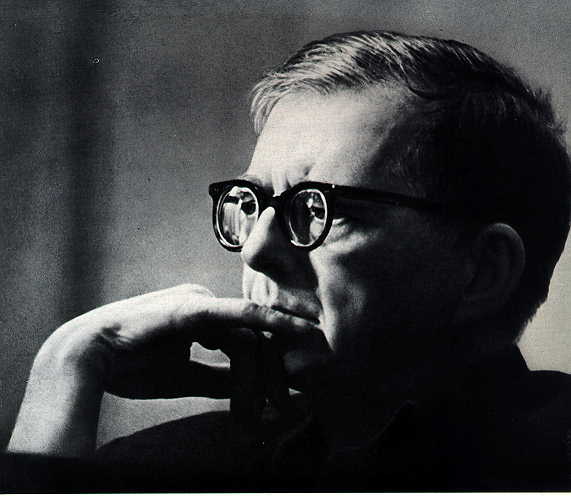Dmitriĭ Shostakovich (1906-1975)
Born September 25, 1906 in St. Petersburg.
Died August 9, 1975 in Moscow.

Symphony No. 9, Opus 70 in E-Flat Major,
Composed during the summer of 1945 (completed August 30).
First Performance: Leningrad Philharmonic, November 3, 1945 with, Yevgeny Mravinsky conducting.
Instrumentation: piccolo, 2 flutes, 2 oboes, 2 clarinets, 2 bassoons, 4 horns in F, 2 trumpets in Bb, 3 trombones, tuba, timpani, percussion and strings.
Shostakovich was expected to produce a grand “Ninth” symphony, complete with a triumphal choral finale, to celebrate the defeat of Germany in World War II. He himself fueled speculation in an interview stating, “I am thinking of my next symphony, the Ninth. I would like to employ not only full orchestra but a choir and soloists, if I can find a suitable text; in any case, I don’t want to be accused of drawing presumptuous analogies.” In fact some musicians had the opportunity in the winter of 1944-1945 to hear the beginning of the new score and reported that it had a triumphal heroic character.
Knowing that such a piece would work to Stalin’s political advantage, Shostakovich began working instead, during August 1945 at the “House of Creativity” in Ivanovo, on something completely different in character. Instead of a “Celebration of our Great Victory,” as announced in a newspaper, he composed a modest chamber work.
The symphony is in five movements.
I Allegro
II Moderato
III Presto
IV Largo
V Allegretto
(Movements II to V are played without a break.).
The Allegro first movement begins with a tune that might have been written by Haydn – except for the trilled “wrong note” at the end. This is the first of many surprises in what appears to be a classic sonata allegro first movement. In fact Bernstein described the entire symphony as “one big series of jokes” where unexpected notes and keys or extra beats are thrown in to keep the listener off balance.
Example 1.
The second subject is introduced by the brash two note rising fourth, played by the trombone, amid a circus-like accompaniment. We will hear that trombone motif often. Another one of the jokes in this movement is the trombone playing this two note motif repeatedly in the wrong place during the recapitulation. He keeps trying until he finally gets it right!
Shostakovich’s treatment of the sonata allegro form – a repeated exposition with two contrasting themes, the second being in the dominant key, followed by a development and finally a recapitulation – is slightly skewed giving the illusion of propriety.
The second movement begins with a plaintive waltz-like melody played by the clarinets.
The mood is quite different from the pratfalls of the first movement. The orchestration is quite transparent and the percussion and trumpets are notably missing. It is more like chamber – or salon music rather than a movement from a mighty Ninth.
The Presto third movement begins with a rollicking theme, introduced by the clarinets, which is soon picked up by the woodwind choir.
Once again the mood changes in the short Largo fourth movement. The trombones and tubas intone a dramatically menacing Mussorgskian fanfare-like theme in octaves.
Example 5. Fourth Movement Brass
Soon a sustained chord is played softly by the strings and a solo bassoon plays a free cadenza-like solo. The low brass interrupt the solo with a fanfare. The bassoon returns with another solo that at once ends and commences the fifth movement.
The finale is a free rondo where a theme is repeatedly presented with episodes in between in the pattern ABACA etc. The initial bassoon solo (the A theme) begins slowly but soon accelerates until picked up by the strings. A contrasting theme (B) is introduced by the oboes accompanied by clarinets which is cut short by a return of the A theme in the high winds. A C minor theme (C) resembling the clarinet melody from his First Symphony emerges over an ostinato in the strings. This theme is developed amid Tchaikovskian brass interjections. The A theme returns in the low strings and rises in register before the C theme returns again. The recapitulation begins with the brass boldly presenting the A theme followed (yet again!) by the C theme. There is a sudden silence before the Allegro coda speedily draws the symphony to a frenetic conclusion.
The response to the symphony was varied. Some commentators thought the composer “responded to the heroic victory of the Soviet people,” and that the work was a “joyful sigh of relief.” Others were bewildered or indignant describing it as “inopportune.”
The opinion of the symphony’s first conductor Yevgeny Mravinsky is perhaps the most insightful: “As a work directed against philistinism, I interpret the Ninth Symphony as an original “symphonic broadside” which ridicules complacency and bombast, the desire to “rest on one’s laurels” – attributes and a state of mind which were particularly dangerous at a time when the war had just ended and the task of healing its wounds lay ahead. To be sure, not all the symphony is ironic – it contains both tender lyricism and deep sadness. The insouciant or frivolous “light-heartedness” of the first movement (think of the secondary subject!) and the element of deliberate and labored gaiety in the finally express, not the composer’s own feelings, but those of his opposite – the self-satisfied, short-sighted philistine who is essentially indifferent to everything.”
In November 1945 Shostakovich told friends that “It is a merry little piece. Musicians will love to play it and critics will delight in blasting it.”
Resources
[amazon template=iframe image&asin=B00000K4J7][amazon template=iframe image&asin=0486288013]






Hi Gene,
can you tell me where you found this image of Shostakovich please? We would like to use it on a CD cover so i need to try and license it and get hold of a high res. If you could let me know that would be great.
Thanks and best
Will